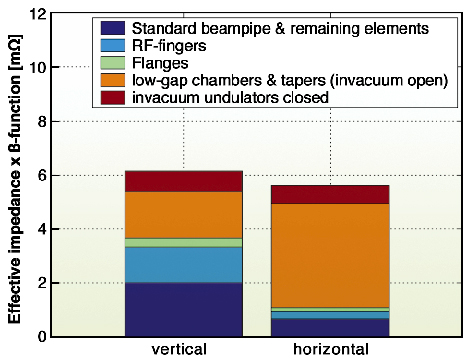- Home
- Users & Science
- Scientific Documentation
- ESRF Highlights
- ESRF Highlights 2004
- The X-ray Source
- Progress in the Modelling of the Impedance of the ESRF Storage Ring
Progress in the Modelling of the Impedance of the ESRF Storage Ring
The interaction of an electron beam with a vacuum chamber with varying and/or small cross section results in a variation of the tune with current (also called detuning) which is particularly significant for the ESRF ring when compared to other synchrotron sources. The interaction of the beam with such chambers can also generate a so-called transverse head-tail instability [2]. The main source of perturbation is the RF-fingers located below the dilatation bellows, the small slit between the flanges connecting adjacent chambers and the low aperture ID chambers and associated tapers connecting them to the larger cross-section of the quadrupole chambers.
The effect can be explained in terms of a wake field. It is an electromagnetic field generated behind a (so-called exciting) particle travelling close to the speed of light in a vacuum chamber. The wake field is a function of the distance s to the particle. The Fourier transformation of the wake field expressed as a function of s is the so-called coupling impedance. It only depends on the shape and electrical properties of the material constituting the vacuum chamber. It is often simply called the impedance of the chamber.
The wake and its associated coupling impedance can be longitudinal, in which case it perturbs the longitudinal oscillations and possibly increases the bunch length and the energy spread. In the following, we shall only deal with the transverse component of the wakefields in the horizontal and vertical planes.
In the past few years, a lot of effort has been put into computing the transverse wake field and its associated coupling impedance produced by the electron beam in each piece of vacuum chamber of the ring. This has been done using the GdfidL computer code [3] and has involved heavy parallel-type computing. The wake field due to the resistivity of the vacuum chamber wall was also taken into account in the analytical calculation.
In this study, it was realised that a significant part of the transverse wake fields are of quadrupolar type [4]. Therefore, a narrow flat chamber with a taper, which is known to generate an important vertical wake, also generates a horizontal wake of opposite polarity. The same is true for resistive wall generated wake fields in a constant cross-section chamber.
 |
|
Fig. 168: Various contributions to the total effective horizontal and vertical coupling impedance (averaged of the power spectrum of a 5 mm bunch) of the ESRF ring weighted by the beta function as predicted from GdfidL computation. |
The tune and the growth/damping of horizontal (vertical) oscillations are perturbed proportionally to the horizontal (vertical) impedance multiplied by the beta function at the place of the chamber inducing the perturbation. Low gap ID chambers are at locations with a low vertical beta function (2.5 to 5 m), while their impedance contribution is very likely the dominant, their overall contributions to the detuning or the instability threshold is reduced. On the other hand, in the horizontal plane, every even-numbered straight section has a large horizontal beta (37 m) function strongly enhancing the contribution to the detuning. This is confirmed experimentally by the observation that, as more and more narrow aperture ID vessels have been installed over the years, the current threshold of vertical instability has not changed very much while the horizontal instability current threshold has been significantly reduced. The horizontal chromaticity of the machine optics had to be increased in order to keep such current threshold constant. This is also clearly visible in Figure 168, which shows contributions to the effective impedance (impedance averaged over the power spectrum of the electron bunch) times the beta function. The orange and the brown contributions are generated by all the insertion device vacuum chambers and the in-vacuum undulators. While the predicted contribution in the horizontal plane matches the one expected from the measured detuning, only half of the observed vertical coupling impedance can yet be accounted for in the calculations made with GdfidL. It is suspected that the missing impedance contributions can be attributed to small elements in the achromat which have not yet been taken into account and/or to geometry simplifications applied to accelerate the simulations.
References
[2] J.L. Revol, R. Nagaoka, P. Kernel, L. Tosi, E. Karantzoulis, EPAC 2000 Vienna
[3] W. Bruns, "The GdfidL Electromagnetic Field Solver", www.gdfidl.de
[4] T.F.Günzel, Coherent and incoherent tune shifts deduced from the modelling of the impedance of the ESRF-ring, EPAC 2004, Lucerne



